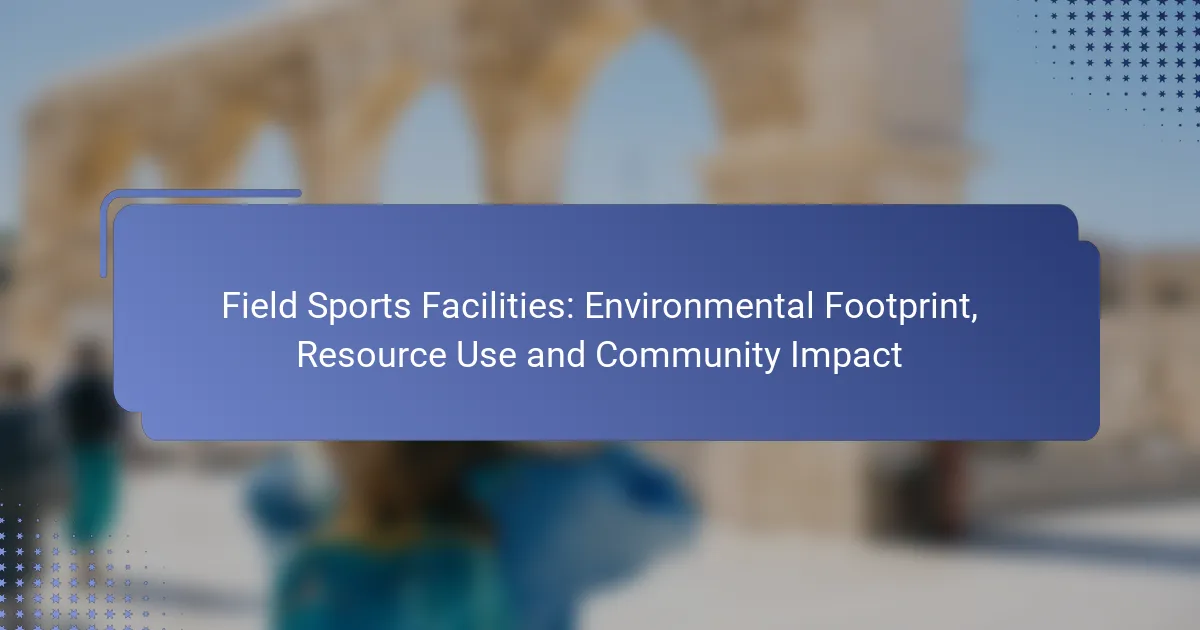Field sports facilities play a vital role in local communities, offering economic, social, and health benefits while also posing environmental challenges. Their operations involve significant resource consumption and waste generation, making it essential to assess and mitigate their ecological footprint. By understanding these impacts, communities can enhance the advantages of these facilities while promoting sustainable practices.

How do field sports facilities impact the environment?
Field sports facilities can significantly affect the environment through their operational practices, resource consumption, and waste management. Understanding these impacts is crucial for minimizing their ecological footprint and enhancing community benefits.
Carbon emissions from facility operations
Carbon emissions from field sports facilities primarily arise from energy consumption for lighting, heating, and maintenance. Facilities that rely on fossil fuels for electricity contribute higher emissions compared to those utilizing renewable energy sources like solar or wind power.
To reduce carbon footprints, facilities can implement energy-efficient technologies, such as LED lighting and high-efficiency HVAC systems. Regular energy audits can help identify areas for improvement, potentially reducing emissions by 20-30% over time.
Water usage and management practices
Water usage in field sports facilities is often significant, especially for irrigation of grass fields and maintenance of amenities. Effective water management practices, such as rainwater harvesting and drought-resistant landscaping, can substantially reduce overall consumption.
Facilities should aim to implement smart irrigation systems that adjust watering schedules based on weather conditions, which can cut water usage by up to 50%. Additionally, using recycled water for irrigation can further alleviate pressure on local water supplies.
Waste generation and recycling efforts
Field sports facilities generate various types of waste, including food waste, plastic bottles, and equipment. Implementing comprehensive recycling programs can help divert a significant portion of this waste from landfills.
Facilities should establish clear recycling guidelines and provide accessible bins for different materials. Engaging the community through educational initiatives can enhance participation in recycling efforts, potentially achieving diversion rates of 30-50% or more.

What resources do field sports facilities consume?
Field sports facilities consume a variety of resources, including energy, materials for construction and maintenance, and land. Understanding these resource demands is essential for minimizing environmental impact and enhancing community benefits.
Energy consumption patterns
Field sports facilities typically rely on electricity for lighting, heating, and powering equipment. Energy consumption can vary significantly based on facility size, usage frequency, and the types of sports played. For example, a large stadium may consume several hundred thousand kilowatt-hours annually, while smaller local fields might use only a fraction of that.
To reduce energy use, facilities can implement energy-efficient lighting, such as LED systems, and consider renewable energy sources like solar panels. Regular energy audits can help identify areas for improvement and optimize consumption patterns.
Material use in construction and maintenance
The construction and maintenance of field sports facilities require various materials, including concrete, steel, and synthetic turf. The choice of materials can significantly impact the environmental footprint, with sustainable options like recycled materials or locally sourced products often being more eco-friendly.
Regular maintenance also necessitates materials such as fertilizers, pesticides, and water for grass fields. Facilities should aim to minimize chemical use by adopting organic practices and efficient irrigation systems to conserve water.
Land use and habitat disruption
Field sports facilities occupy significant land areas, which can lead to habitat disruption and loss of biodiversity. The development of these facilities often requires clearing natural vegetation, which can affect local ecosystems. Careful site selection and planning can mitigate these impacts.
To minimize habitat disruption, facilities can incorporate green spaces, native plant landscaping, and buffer zones. Engaging with local communities and environmental groups during the planning phase can also help address concerns and promote sustainable practices.

How do field sports facilities benefit local communities?
Field sports facilities provide numerous advantages to local communities by enhancing economic activity, fostering social connections, and promoting health. These facilities serve as hubs for various activities, encouraging participation and engagement among residents.
Economic contributions to local businesses
Field sports facilities stimulate local economies by attracting visitors who spend money on nearby businesses such as restaurants, shops, and hotels. Events hosted at these venues can draw large crowds, leading to increased sales for local vendors.
Moreover, the construction and maintenance of these facilities create job opportunities, ranging from construction workers to facility management staff. This influx of employment can significantly boost the local economy.
Social engagement and community programs
These facilities often serve as venues for community programs, including youth leagues, adult recreational sports, and special events. By providing a space for these activities, field sports facilities encourage social interaction and foster a sense of belonging among residents.
Community programs can also focus on inclusivity, offering activities for diverse groups, including those with disabilities. This engagement helps build stronger community ties and promotes teamwork and cooperation.
Health and wellness benefits for residents
Field sports facilities promote physical activity, which is essential for maintaining health and wellness. Access to these venues encourages residents to participate in sports and exercise, contributing to improved physical fitness and mental well-being.
Regular participation in sports can reduce the risk of chronic diseases, enhance mood, and improve social skills. Communities with accessible sports facilities often see higher levels of overall health among their residents.

What are the best practices for sustainable field sports facilities?
Best practices for sustainable field sports facilities focus on minimizing environmental impact while maximizing resource efficiency and community benefits. Implementing strategies such as green building certifications, water-efficient landscaping, and renewable energy integration can significantly enhance sustainability.
Green building certifications
Green building certifications, such as LEED or BREEAM, provide frameworks for designing and operating sustainable facilities. These certifications often require adherence to specific standards regarding energy efficiency, material sourcing, and indoor environmental quality.
Facilities aiming for certification should conduct energy audits, use sustainable materials, and ensure proper waste management. Achieving these certifications not only reduces the environmental footprint but can also attract funding and community support.
Water-efficient landscaping techniques
Water-efficient landscaping techniques, including xeriscaping and the use of native plants, help minimize water usage in field sports facilities. These practices promote biodiversity and reduce the need for irrigation, which is crucial in areas facing water scarcity.
Implementing rainwater harvesting systems can further enhance water efficiency. Facilities can collect and utilize rainwater for irrigation, reducing reliance on municipal water supplies and lowering operational costs.
Renewable energy integration
Integrating renewable energy sources, such as solar panels or wind turbines, can significantly reduce a facility’s carbon footprint. These systems can provide a substantial portion of the energy needed for lighting, heating, and cooling.
Facilities should assess their energy needs and site conditions to determine the most suitable renewable options. Investing in renewable energy not only lowers utility costs but also demonstrates a commitment to sustainability, potentially attracting environmentally conscious users and sponsors.

How can communities assess the impact of field sports facilities?
Communities can assess the impact of field sports facilities through a combination of community feedback, environmental impact assessments, and long-term monitoring strategies. These methods help gauge both the social and ecological effects of such facilities, ensuring they meet community needs while minimizing negative consequences.
Community feedback mechanisms
Community feedback mechanisms involve gathering input from local residents about their experiences and perceptions of field sports facilities. This can be done through surveys, public meetings, or online platforms where community members can voice their opinions and suggestions.
Engaging with the community regularly helps facility managers understand usage patterns, satisfaction levels, and any concerns regarding noise, traffic, or safety. Implementing a structured feedback process can lead to improvements that align with community expectations.
Environmental impact assessments
Environmental impact assessments (EIAs) evaluate the potential effects of field sports facilities on local ecosystems. These assessments typically consider factors such as land use, water consumption, and habitat disruption, ensuring that any development complies with environmental regulations.
Communities should require EIAs before construction begins, as they provide essential data for making informed decisions. Engaging environmental experts can help identify mitigation strategies to reduce negative impacts, such as using sustainable materials or implementing water-saving technologies.
Long-term monitoring strategies
Long-term monitoring strategies involve tracking the ongoing effects of field sports facilities on both the community and the environment. This can include regular assessments of air and water quality, as well as monitoring community engagement and satisfaction over time.
Establishing key performance indicators (KPIs) can help communities measure success. Examples of KPIs include the number of community events held, user satisfaction ratings, and ecological health indicators. Consistent monitoring allows for timely adjustments to facility management practices, ensuring they remain beneficial to the community and the environment.

What emerging trends are shaping field sports facilities?
Emerging trends in field sports facilities focus on sustainability, community engagement, and technological integration. Facilities are increasingly designed to minimize environmental impact while enhancing user experience and accessibility.
Sustainability Practices
Sustainability practices in field sports facilities include the use of eco-friendly materials, energy-efficient lighting, and rainwater harvesting systems. Facilities are adopting green certifications, such as LEED, to showcase their commitment to environmental stewardship.
For example, synthetic turf made from recycled materials reduces water usage and maintenance costs. Implementing solar panels can significantly lower energy bills, making operations more cost-effective in the long run.
Community Engagement
Community engagement is vital for the success of field sports facilities. Facilities are increasingly designed to serve not just athletes but also local residents by providing multipurpose spaces for various activities.
Hosting community events, workshops, and fitness programs can foster a sense of ownership and encourage local participation. Facilities that prioritize community needs often see higher usage rates and stronger support from local governments and organizations.
Technological Integration
Technological integration in field sports facilities enhances user experience and operational efficiency. Innovations such as smart lighting, mobile apps for scheduling, and real-time performance tracking are becoming standard.
For instance, using apps for booking fields can streamline operations and reduce conflicts. Additionally, performance analytics tools can help athletes improve their skills while providing coaches with valuable insights.



